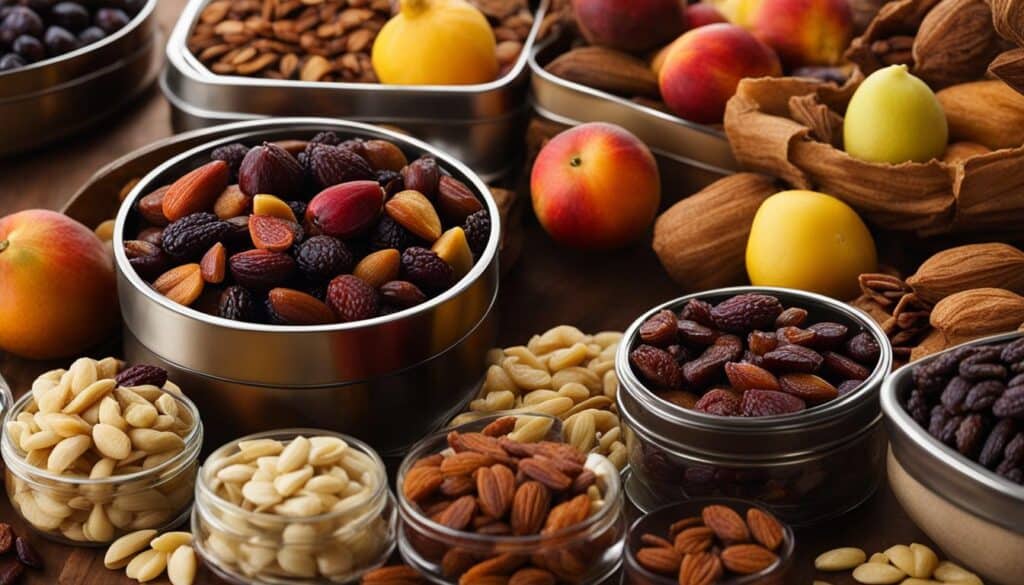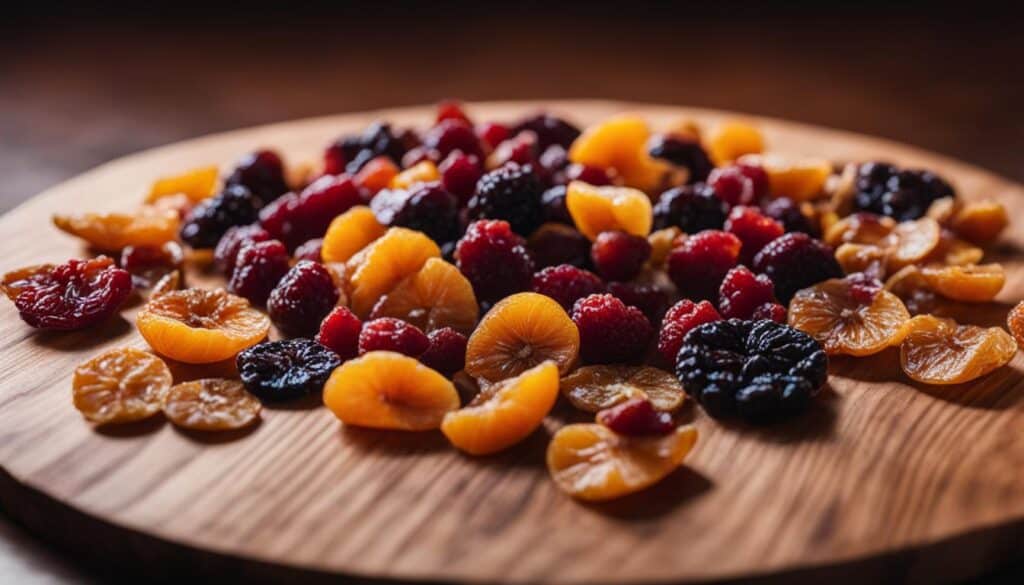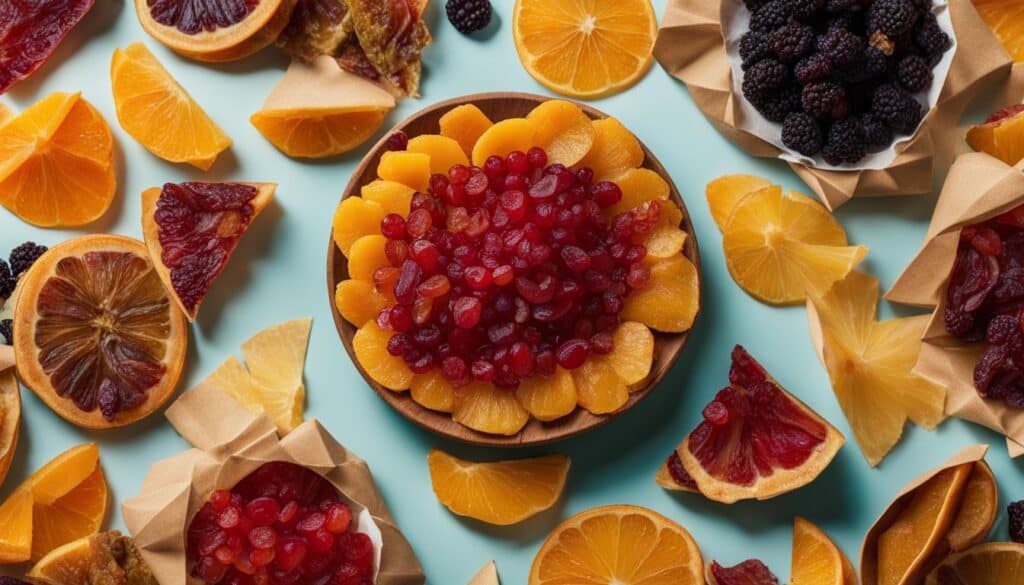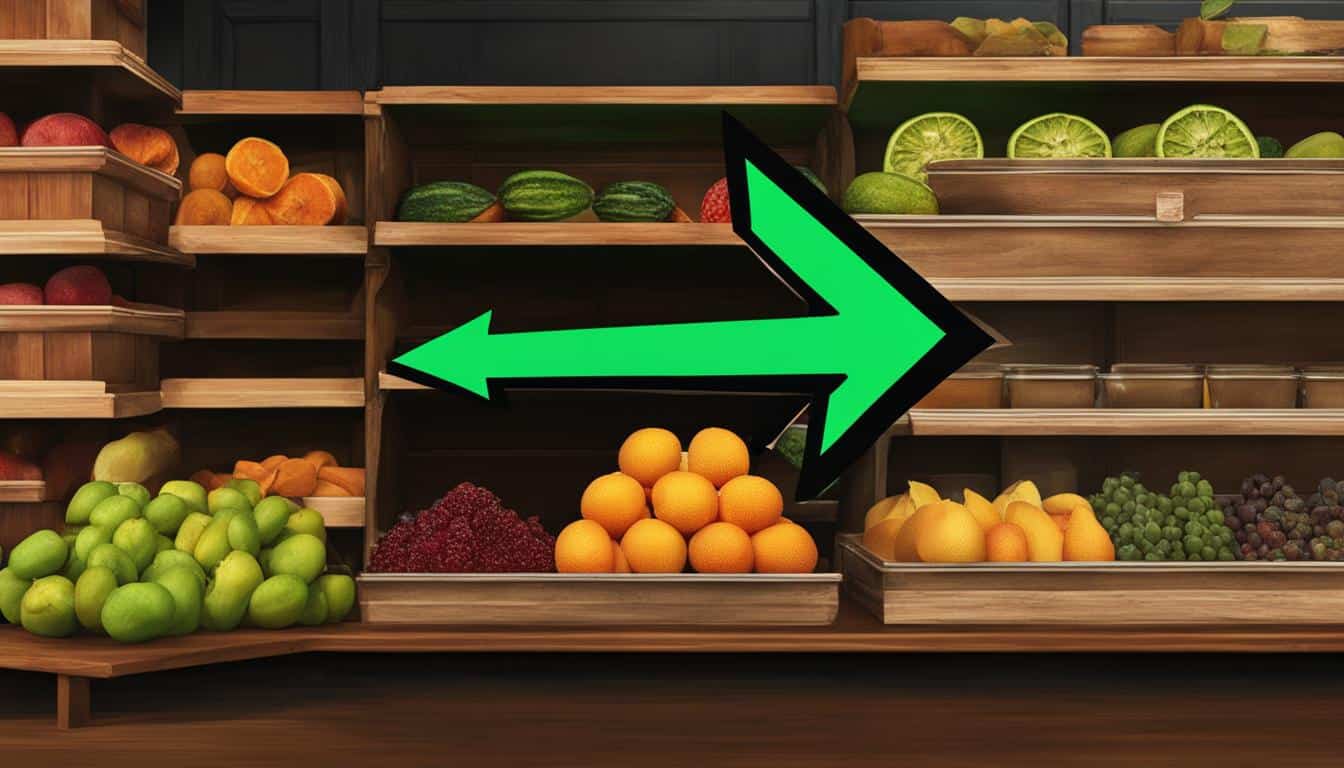Welcome to our comprehensive guide on the shelf life of dried fruit and whether it can go bad. Dried fruit is a delicious and convenient snack, packed with nutrients and natural sweetness. However, to ensure that your dried fruit remains fresh and safe to consume, it’s essential to understand its expiration and proper storage. In this article, we will reveal the truth behind the longevity of dried fruit and provide you with valuable fruit safety tips.
Key Takeaways:
- Dried fruit needs to be stored properly to maintain its flavor, nutrients, and shelf life.
- The ideal storage conditions for dried fruit include a cool temperature, low humidity, and airtight packaging.
- Glass jars, plastic containers, and vacuum-sealed bags are suitable options for storing dried fruit.
- Avoid common mistakes such as exposing dried fruit to air and light or using non-food grade containers.
- Expired dried fruit may pose safety concerns and experience a decline in quality.
The Ideal Storage Conditions for Dry Fruits
Proper storage is crucial for preserving the flavor, nutritional value, and extending the shelf life of dried fruits. To ensure the longevity of your dried fruits, it is important to create the ideal storage conditions.
Air-Tight Containers
Using air-tight containers is essential for maintaining the freshness of dried fruits. These containers lock out oxygen, preventing the breakdown of nutrients and the growth of bacteria. Choose containers that are specifically designed for food storage to avoid any potential contamination.
Temperature and Humidity
The temperature at which you store your dried fruits plays a vital role in their longevity. The ideal temperature range is between 50°F and 70°F (10°C and 21°C). This temperature range helps to prevent bacterial growth and maintain the quality of the dried fruits.
In addition to temperature, humidity levels are also important. Low humidity helps to prevent the absorption of moisture, which can lead to changes in texture and taste. Aim for a humidity level below 60% to ensure the best storage conditions for your dried fruits.
Light Exposure and Location
Exposure to sunlight can degrade the quality of dried fruits. Therefore, it is important to store them in a cool, dark location. Sunlight can cause the dried fruits to lose their color and flavor, so it is best to keep them away from direct light.
Find a cool spot in your pantry or cupboard to store your dried fruits. Avoid placing them near the stove, oven, or any other heat source that could cause them to spoil or lose their freshness.
Summary:
- Store dried fruits in air-tight containers to maintain freshness.
- Maintain a temperature range of 50°F to 70°F (10°C to 21°C) to prevent bacterial growth.
- Keep humidity below 60% to avoid changes in texture and taste.
- Avoid exposing dried fruits to direct sunlight to preserve color and flavor.
- Choose a cool, dark location in your pantry or cupboard for storage.
Types of Suitable Containers for Dry Fruits
When it comes to storing dried fruits, choosing the right container is essential to maintain their quality and prevent spoilage. Here are some types of suitable containers for keeping your dried fruits fresh:
Glass Jars
Glass jars are a popular choice for storing dried fruits because they provide transparency, allowing you to easily identify the contents. They also come with air-tight lids, which help seal in freshness and prevent moisture from getting in. The transparency of glass jars makes them not only practical but also visually appealing, allowing you to showcase the beautiful colors and textures of your dried fruits.
Plastic Containers
Plastic containers, especially those marked as BPA-free, are another option for storing dried fruits. These containers typically come with tight-sealing lids that help preserve the freshness of the fruits. It’s important to choose food-grade plastic containers to ensure that no harmful chemicals or contaminants leach into your dried fruits. Plastic containers are lightweight and durable, making them convenient for both storing and transporting your dried fruits.
Vacuum-Sealed Bags
If you want to extend the shelf life of your dried fruits even further, consider using vacuum-sealed bags. These bags remove excess air from the packaging, preventing oxidation and maintaining the taste and texture of the fruits. Vacuum-sealed bags are particularly useful for long-term storage or when you need to take your dried fruits on outdoor adventures like hiking or camping. They provide a compact and airtight solution that keeps your dried fruits fresh and delicious.
Choose a container that suits your needs and preferences to ensure the longevity and quality of your dried fruits. Whether you opt for glass jars, plastic containers, or vacuum-sealed bags, proper storage is key to enjoying the full flavor and nutritional benefits of dried fruits.

Common Mistakes to Avoid When Storing Dry Fruits
Properly storing dry fruits is essential for preserving their flavor, texture, and nutritional value. However, there are some common mistakes that people often make when it comes to storing these nutritious treats. By being aware of these mistakes and taking steps to avoid them, you can ensure that your dry fruits stay fresh and delicious for longer.
Avoiding Exposure to Air and Light
One of the most common mistakes in storing dry fruits is exposing them to open air and light. Oxygen and sunlight can accelerate the oxidation process, leading to a loss of flavor and nutritional quality. To prevent this, store your dry fruits in airtight containers that block out light. This will help preserve their freshness and extend their shelf life.
Mixing Varieties Improperly
Another mistake to avoid is mixing different varieties of dry fruits together. Each fruit has its own unique flavor and aroma, and when mixed improperly, they can transfer their flavors and affect the overall taste of the fruits. To maintain the distinct flavors of each dry fruit, store them separately or use separate containers for each variety.
Using Non-Food Grade Containers
Using non-food grade containers for storing dry fruits can be a serious mistake. Non-food grade containers may contain harmful chemicals or contaminants that can leach into the fruits and cause health issues. It is important to choose containers that are specifically designed for storing food, such as glass jars or BPA-free plastic containers, to ensure the safety and quality of your dry fruits.
| Common Mistakes to Avoid When Storing Dry Fruits |
|---|
| Avoiding Exposure to Air and Light |
| Mixing Varieties Improperly |
| Using Non-Food Grade Containers |
By avoiding these common mistakes and following proper storage practices, you can ensure that your dry fruits retain their freshness, flavor, and nutritional value for a longer period. Remember to store them in airtight containers, protect them from exposure to air and light, and use appropriate food-grade containers. With these simple steps, you can enjoy the delicious taste and health benefits of dry fruits for months to come.
Safety Concerns and Quality of Expired Dried Fruits
Expired dried fruits may present safety concerns and quality issues that consumers should be aware of before consuming them. When dried fruits exceed their expiration date, there is a higher risk of microbial growth and potential contamination, which can lead to foodborne illnesses. It is important to evaluate the signs of spoilage before consuming expired dried fruits to ensure personal safety.
In addition to safety concerns, the quality of expired dried fruits deteriorates over time. The taste, texture, and nutritional value may significantly decline, making them less enjoyable and nutritious. Signs of spoilage may include the presence of mold, an off-putting odor, or changes in texture such as sogginess or hardness.
It is crucial to understand the potential risks associated with consuming expired dried fruits and the importance of evaluating their quality before consumption. By being vigilant and observing the signs of spoilage, individuals can make informed decisions about whether to consume expired dried fruits or discard them to prioritize their health and well-being.
Note: The image above illustrates the potential safety concerns of expired dried fruits.
Determining the Safety of Expired Dried Fruits: Signs of Spoiled Dried Fruits
When it comes to expired dried fruits, it’s essential to know how to determine if they are still safe to eat. By understanding the signs of spoiled dried fruits, you can make an informed decision about consuming them and avoid any potential health risks.
Visible signs of spoilage serve as reliable indicators of whether or not dried fruits have gone bad. Mold growth, whether white, green, or black, is a clear indication that the fruits are no longer safe to consume. Additionally, if you notice any discoloration, such as dark spots or changes in the fruit’s natural color, it’s best to avoid eating them. Trust your senses, and if you detect an unusual smell from the dried fruits, it’s a sign that they have deteriorated and should be discarded.
Changes in texture can also suggest that dried fruits have spoiled. If the fruits feel excessively dry, overly soft, or sticky, it’s best to err on the side of caution and refrain from consuming them. Lastly, consider the integrity of the packaging. If the packaging appears damaged, compromised, or if there are any signs of insects or pests, it’s best to discard the dried fruits.
Remember, when in doubt, it’s best to discard any expired dried fruits rather than risking your health. By being aware of the signs of spoiled dried fruits, you can ensure that you consume only safe and high-quality products.

Signs of Spoiled Dried Fruits:
- Mold growth (white, green, or black)
- Discoloration (dark spots, changes in natural color)
- Unusual smell
- Changes in texture (excessively dry, overly soft, sticky)
- Damaged or compromised packaging
- Presence of insects or pests
By keeping an eye out for these signs and trusting your senses, you can ensure that the dried fruits you consume are safe and enjoyable.
Understanding the Purpose of Expiration Dates on Dried Fruits
Expiration dates on dried fruits serve two important purposes: ensuring consumer safety and assessing the quality of the product. These dates indicate the point beyond which a dried fruit may become unsafe to consume and may experience a decline in quality. Determining the expiration dates involves extensive testing and analysis conducted by food manufacturers and regulatory authorities. It is crucial for consumers to understand the significance of these dates to make informed decisions about the consumption of dried fruits.
Interpreting expiration dates on dried fruits involves evaluating various factors. The dates are determined based on the specific characteristics and composition of each dried fruit variety. Factors such as moisture content, sugar levels, acidity, and the presence of preservatives or additives influence the shelf life of dried fruits. Manufacturers take these factors into account when establishing an expiration date that ensures the product’s safety and maintains the desired quality.
“Expiration dates on dried fruits indicate the point beyond which a dried fruit may become unsafe to consume and may experience a decline in quality.”
Consumers should carefully assess the expiration dates on dried fruits before consumption. It is essential to follow the guidelines provided on the packaging, as these dates are set to ensure optimal freshness and safety. Expired dried fruits may pose health risks due to microbial growth and potential contamination. Additionally, their quality may deteriorate, resulting in changes in taste, texture, and nutritional value. By understanding the purpose of expiration dates and interpreting them correctly, consumers can make informed decisions about the safety and quality of dried fruits.

Determining the Freshness of Dried Fruits:
- Check the expiration date on the packaging.
- Inspect for any signs of spoilage, such as mold, discoloration, or an unusual smell.
- Assess changes in texture, such as excessive hardness or stickiness.
- Consider the integrity of the packaging, ensuring it is intact without any damage or punctures.
By following these steps, consumers can ensure the safety and quality of dried fruits and enjoy them at their best.
Factors Affecting the Shelf Life of Dried Fruit
When it comes to the shelf life of dried fruit, several factors come into play. Understanding these factors can help consumers make informed decisions about storage and consumption. Here are some key factors that can affect the shelf life of dried fruit:
- Type of Fruit: Different types of fruits have varying moisture contents, sugar concentrations, and acidity levels, which can impact how long they can be stored.
- Presence of Preservatives and Additives: Some dried fruits may contain preservatives or additives to extend their shelf life. These can influence the longevity of the product.
- Packaging: The quality of the packaging plays a crucial role in preserving the freshness of dried fruit. Properly sealed and airtight packaging helps to keep out oxygen and moisture, which can lead to spoilage.
- Storage Conditions: Temperature, humidity, and light exposure can significantly impact the shelf life of dried fruit. Storing them in cool, dry, and dark places can help maintain their quality and prevent deterioration.
- Exposure to Oxygen: Oxygen can cause oxidation, which can degrade the flavor, texture, and nutritional value of dried fruit. Minimizing exposure to oxygen can help prolong their shelf life.
- Potential Contamination: Contamination from pests, bacteria, or mold can accelerate the spoilage of dried fruit. Proper handling and storage practices can help prevent contamination and extend the shelf life.
By considering these factors, consumers can make informed choices about purchasing, storing, and consuming dried fruit. Following proper storage guidelines and being mindful of expiration dates can ensure that dried fruit stays fresh and enjoyable for longer periods.
“Properly sealed and airtight packaging helps to keep out oxygen and moisture, which can lead to spoilage.”
Dried fruit can be a convenient and nutritious snack. By understanding the factors that affect its shelf life, consumers can make the most of their dried fruit purchases and enjoy their flavors and benefits for extended periods.
Tips for Extending the Shelf Life of Dried Fruit
Proper storage is essential for extending the shelf life of dried fruits. Here are some tips to help you keep your dried fruits fresh and flavorful for a longer period:
- Store in optimal temperature and humidity conditions: Dried fruits should be stored in a cool, dry place with a temperature range of 50°F to 70°F (10°C to 21°C). Avoid storing them in areas with high humidity, as moisture can lead to spoilage.
- Use air-tight containers: Transfer dried fruits to air-tight containers, such as glass jars or plastic containers with tight-sealing lids. This helps to prevent exposure to air, which can cause oxidation and moisture absorption.
- Avoid exposure to air and light: Dried fruits are sensitive to air and light, which can degrade their quality and shorten their shelf life. Keep them away from open air and store them in dark locations or opaque containers to minimize light exposure.
- Prevent contamination: Ensure that the containers used for storing dried fruits are food-grade and free from any harmful chemicals or contaminants. It is also important to keep dried fruits away from strong-smelling substances, as they can absorb odors easily.
By following these simple tips, you can enjoy the freshness and nutritional benefits of dried fruits for a longer period. Remember to regularly check for any signs of spoilage, such as mold or unusual odors, before consuming expired dried fruits. With proper storage, you can savor the delicious flavors of dried fruits and incorporate them into your favorite recipes.

Table: Comparison of Storage Methods for Dried Fruits
| Storage Method | Pros | Cons |
|---|---|---|
| Air-tight Containers | – Prevents exposure to air and moisture – Maintains freshness and flavor – Easy identification of contents | – Requires additional storage space – Glass jars can break if mishandled |
| Vacuum-Sealed Bags | – Removes excess air to prevent oxidation – Preserves taste and texture – Space-saving storage option | – Bags can be punctured or torn – Limited visibility of the contents |
| Food-Grade Plastic Bags | – Budget-friendly option – Provides some level of protection from air and moisture | – Not as effective as air-tight containers – May not provide complete barrier against moisture |
“Proper storage ensures the freshness, flavor, and nutritional value of dried fruits for a longer period.”
Remember, storing dried fruits correctly is the key to maintaining their quality and extending their shelf life. By implementing these tips, you can enjoy the convenience and health benefits of dried fruits for an extended period without compromising on taste or nutritional value.
Conclusion
Proper storage is crucial for preserving the quality and extending the shelf life of dried fruits. By following the recommended storage conditions, using suitable containers, and avoiding common mistakes, you can enjoy dried fruits at their best for a longer period. Whether you’re a fan of dried apricots, raisins, or mango slices, these tips will help you make the most of your dried fruit supply.
Remember, maintaining the ideal temperature range of 50°F to 70°F (10°C to 21°C) and low humidity is key to prevent bacterial growth and ensure the texture and taste remain intact. Using air-tight containers, such as glass jars or BPA-free plastic containers, will help lock out oxygen and preserve freshness. Additionally, avoid exposure to sunlight and store dried fruits in cool locations to further extend their shelf life.
It is important to be aware of safety concerns and quality issues related to expired dried fruits. Consuming expired dried fruits may lead to foodborne illnesses, and the taste, texture, and nutritional value can deteriorate over time. To determine if expired dried fruits are still safe to eat, check for visible signs of spoilage, such as mold or unusual smells, and trust your senses when in doubt.
By understanding the purpose of expiration dates and considering the factors that can affect the shelf life of dried fruits, you can make informed decisions about storage and consumption. Following these guidelines will ensure that your dried fruits remain delicious, flavorful, and nutritious for an extended period.
FAQ
Can dried fruit go bad?
Yes, dried fruit can go bad if not stored properly.
What is the shelf life of dried fruit?
The shelf life of dried fruit varies depending on storage conditions and other factors, but it can typically last for several months to a year.
How long does dried fruit last?
The longevity of dried fruit depends on various factors such as the type of fruit, storage conditions, and the presence of preservatives. Properly stored dried fruit can retain its quality for an extended period.
What are the ideal storage conditions for dry fruits?
Dry fruits should be stored in a cool location with temperatures ranging from 50°F to 70°F (10°C to 21°C). Low humidity, air-tight containers, and avoiding exposure to light are also important for proper storage.
What types of containers are suitable for storing dry fruits?
Glass jars with air-tight lids, BPA-free plastic containers with tight-sealing lids, and vacuum-sealed bags are suitable containers for storing dry fruits.
What are common mistakes to avoid when storing dry fruits?
It is important to avoid exposing dry fruits to open air and light, as well as mixing varieties improperly. Using non-food grade containers can also introduce harmful chemicals or contaminants.
Are there safety concerns and quality issues with expired dried fruits?
Expired dried fruits may pose safety concerns due to microbial growth and potential contamination. The quality of expired dried fruits can also deteriorate in terms of taste, texture, and nutritional value.
How can I determine if expired dried fruits are still safe to eat?
Check for visible signs of spoilage, such as mold, discoloration, or an unusual smell. Evaluate changes in texture and consider the integrity of the packaging. Trust your senses and exercise caution when consuming expired dried fruits.
What is the purpose of expiration dates on dried fruits?
Expiration dates on dried fruits ensure consumer safety and assess the quality of the product. These dates indicate the point at which a dried fruit may become unsafe to consume and experience a decline in quality.
What factors affect the shelf life of dried fruit?
The shelf life of dried fruit can be influenced by factors such as the types of fruits used, the presence of preservatives and additives, packaging, storage conditions, exposure to oxygen, and potential contamination.
How can I extend the shelf life of dried fruit?
To extend the shelf life of dried fruit, store them in proper temperature and humidity conditions, use air-tight containers, avoid exposure to air and light, and prevent contamination.





Leave a Reply